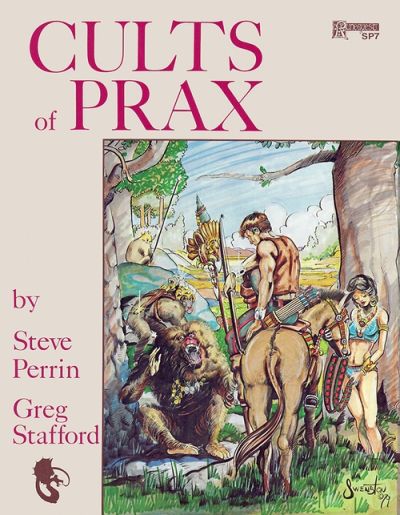Yet In My Dreams I’d Be
Cults of Prax
By Steve Perrin & Greg Stafford

13 Oct, 2019
Steve Perrin and Greg Stafford’s 1979 booklet Cults of Prax is a source book for the venerable RuneQuest roleplaying game. It was, I believe, the second publication in the RuneQuest line. Cults of Prax outlines the religions found in Prax, a wasteland adjacent to the Dragon Pass region featured in the original rule set. This booklet fleshed out the backstory to the world of Glorantha, the setting used for most (but not all) editions of RuneQuest.
The somewhat dry material was spiced up with comments from a wandering trader with long experience of the peoples of the Prax region.
Unlike old school Dungeons & Dragons, magic was not limited to specialists. Anyone in RuneQuest could use magic and most characters did. For the most part, access to magic was gained via “cults,” a blanket term for all Gloranthan religions. What magic any particular person drew on was therefore governed by the nature of the god they followed.
~oOo~
Each cult entry listed the following information:
Mythos and history
The stories the cult told about itself and some details of its existence since time began.
The nature of the cult
What niche the cult occupies to justify its continued existence, the cult’s circumstances in current day Prax, and the cult’s likes and dislikes.
Organization
The cult’s current administrative structure. Some cults take a far more formal approach to this issue than others.
Lay membership
The obligations and benefits of rank and file membership.
Initiate Membership
The obligations and benefits of a more intense commitment to the cult. As a rule, the higher one ascends in the cult hierarchy, the greater the benefits to the member and the greater the obligations to the cult.
Rune lord membership
The obligations and benefits of ... you know where this is going, right? Rune Lords are senior members of the cult, the ones specializing in physical skills.
Rune priest membership
The obligations and benefits of Rune Priests. Rune Priests are senior members of the cult, ones who specialize in spiritual skills.
Subservient cults
This covers each cult’s “spirit of retribution,” the entity who pops by to chat with cult members when they violate their particular cult’s major laws. Dealing with spirits of retribution ranges from “very bad” to “extremely bad” and can be the transgressor’s final experience.
Associated cults
Various cults affiliated with the major cults.
Miscellaneous
Anything useful to know about the cult that does not fall into one of the previous categories.
~oOo~
Also included: a guide to gods1:
- Barbarian gods (gods present in Prax since Glorantha’s first days)
- Invader deities (gods introduced to the region in historical times)
- Lightbringers (gods of the civilized lands, often not well established in Prax)
- Non-human deities (old gods eclipsed by the rise of humans but still of note)
Plus appendices covering details such as each cult’s holy days and (very important for groups whose player characters belonged to different cults), how each cult related to each of the others. Love, hate, despise. Fucking Storm Bull cultists!
General comments
To modern eyes, the physical product may not seem all that impressive. The cover is mediocre; the interior art is uninspired. The product dates from long-ago times when staples were acceptable. People used to today’s standard (perfect binding, handy indexes) might think this booklet crude. Cults is somewhat crude. Yet it is notable because it taught gamers to expect more and companies to provide it.
Other RPGs might have had religious classes, but the details were often left to the players’ imaginations (or skipped over entirely). Religion is a core part of the Gloranthan setting, a vital part of each player character’s life. Cults of Prax provided some of the background which Stafford had been constructing since the 1960s. The booklet was much more than the dry listing of characteristics that my first section might suggest. Cults of Prax took an anthropological approach to describing and analyzing the worldviews of the folks populating Stafford’s Bronze-Age-inspired setting. Few other companies offered this sort of in-depth support; many of the companies that later did2 were no doubt inspired by the example that Chaosium set.
As well, the details provided about Glorantha and its inhabitants made it clear to gamers that Stafford’s world wasn’t just a thinly disguised copy of older, well established properties. RuneQuest elves own nothing to Mr. Tolkien’s. Likewise, Glorantha’s trolls are unique to Glorantha.
Cults of Prax was followed by a rich assortment of supplements fleshing out even more aspects of Glorantha. Indeed, the odd minor supplement like QuestWorld or Thieves World aside, to play RuneQuest was to adventure in Glorantha. So of course when Avalon Hill purchased the rights to publish their own version of what was then the second most popular roleplaying game on the market, the Gloranthan elements were allowed to languish....
Cults of Prax is available here.
The full list of gods:
The barbarian gods
- Daka Fal
- Storm Bull
- Waha
- Eiritha
Invader deities
- Humakt
- The Seven Mothers
- Pavis
- Yelmalio
Lightbringers
- Issaries
- Chalana Arroy
- Llankor Mhy
- Orlanth
Non-human deities
- Kyger Litor
- Zorak Zoran
- Aldrya
TSR provided AD&D players with their equivalent, Deities & Demigods, the year after Cults of Prax came out. In the grand TSR tradition, hit points were provided for the convenience of those player characters whose first reaction to meeting a divine being is to stab them before looting their bodies.
No hit points are provided for Gloranthan gods. Attempting to mug one would be ill-advised.
